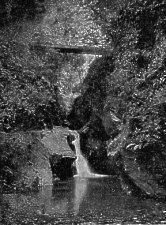
Glen Maye-Same Then as Now.
[From The Manxman, #1 1911]
"If the St. George people had treated the Island properly, the Steam Packet boat would never have been thought of."-From the " Manx Sun," September 28th, 1830.
Elsewhere in this issue the late Rev. T. E. Brown tells us something personal about the really original Manx commander of 1830, Captain William Gill, but my object to-day is to show the tourist of 1910 how the steamers he is now so proud of came into being.
Folks are never tired of extolling the wonderful achievements of the Victorian era, but nothing so far recounted surpasses in interest the extraordinary development of the Steam Packet Company. It is a sort of commercial romance. Probably no co-partnership has yet occupied so unique a position as this one does. There is a common saying that " the history of the steam packets is the history of the Isle of Man," and it is impossible to controvert it, but, as George Eliot wisely -observed, "no retrospect takes us to the true beginning," a saying which very aptly applies in this case. At all events as early as the year 1816 mails were sent to the Isle of Man by means of a small steamer which was supposed to leave Whitehaven every Monday night, returning from Douglas on the following Thursday. She was, however, very often delayed, sometimes even " two or three weeks," so that no reliance was placed on her. Still, Whitehaven must be held as about the earliest steam station.
The chief mails, of course, even then came from Liverpool by means of the sailing smacks, one of their number being the " Duchess of Athol," commanded by no less renowned a navigator than Captain Gill, about whom Mr. Brown has written. I have a water-colour drawing in my possession, the subject depicted being the arrival (1823) of the Duchess alongside the Red Pier at Douglas, much as it is the present day. I am advised by those qualified to judge that the smack, or cutter, is tolerably well drawn. There is a carriage on the quay and a handful of people as well. A big flwr is fivin.g also.

Glen Maye-Same Then as Now.
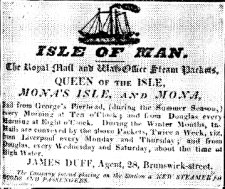
The Company's Oldest Handbill-1834.
I skip now to the year 1829. Douglas was then "waking up." The population of the island was over 40,000, and these people derived their living from agriculture, fishing, manufactures, and the fact of many retired army and navy officers living amongst them. The boarding-house business, as it is known now, was, of course, then nonexistent.
There was no Loch Promenade-residential Douglas, as far as the front was concerned, began at Broadway. Finch-road was a field, and many notabilities resided in Athol-street, now the place of business of lawyers and commercial men. In those days the court house was on the quay-somewhere between the present Royal Hotel and the Steam Packet Offices-and both the bankers (alas! they have all gone) and the advocates were then behind Victoria-street, and even on the South Quay. Visitors, anxious to tally these matters off for themselves, must direct their steps to Fort, and adjacent streets, for there can be seen some of the old residences of Douglas legal notabilities, and, if you can get someone to point it out to you, even the birthplace of a Duke of Athol.
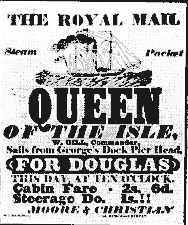
The oldest Shipping Poster in the world-1836
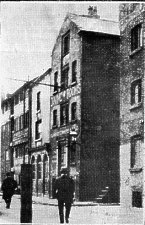
The first office, in Liverpool, of the Isle of Man Steam Packet
Co.-1830.
It is situated near the Landing Stage, a few yards from the south side of the-new
Dock-Board Offices, on a little island of condemned property. Near to it is
the (now closed) Packet Inn, so named after the Manx boats early last century.
In this year of 1829 the mails were carried by the St. George's Steam Packet Company of Liverpool, a concern of importance, trading in numerous directions to various -ports, -- and evidently regarding the Manx traffic as agreeable "pickings " in July and August, but not particularly anxious what became of it in the remaining months. The mails generally came on three days a week for a short time in summer, and perhaps once a fortnight in winter. During the busy months named, a steamer called the " Sophia Jane " ran ón the Manx station. She was bighly regarded by the public, and sometimes made the 'passage in ten or eleven hours. In the remaining months other steamers carried the St. George flag; they were small, dirty, inefficient, and not particularly stable. Sometimes the wind carried them to Peel and sometimes to Castletown, the engines being apparently a secondary consideration to the sails, and generally the passage occupied twenty or more hours. It is clear no nation could for long stand this. The situation became acute, and a meeting was held on January 5th, 1830, to " take into consideration the proposals for building a steam boat." Liverpool was charged with having " drained " the island of its agriculture and manufactures, sand now wanted to " arbitrarily dictate " in what ships its people and their letters should be carried.
In the room was subscribed £7,000 for building the Mona's Isle, and she was launched on the 10th June, 1830, being described by the " Greenock Advertiser," as a very superior steam vessel of 200 tons, to be propelled by two engines of superior power." Captain Gill, who had left the "Duchess " for the "Douglas " sailing trader, was appointed to the command. It is needless to say how pleased I yam at being able to give this worthy old skipper's portrait, probably no coastwise ship master sailing from the port of Liverpool ever earned greater celebrity and reputation. Captain ,Gill, the now great Company's first commodore, was a Ramsey ship-carpenter, who however, had from his early youth displayed a singular taste for the sea. When he, came, to command the Mona's Isle he had against; him all the resources of the St. George's Company, who, soon wearying of their " Sophia Jane," which I have mentioned, being regularly beaten " by nearly an hour on fine and up to six hours on dirty days," placed against the "Isle " their famous "St. George," the ne plus ultra of the fleet, a large and fast boat. Than Captain Gill no man living better understood the management of a boat, and certainly no man better understood the winds, currents, and tides which prevailed between Liverpool and Manx ports. It so happened that the day before the first of many races with the " St. George," the wind was blowing strongly from the south-west, which is, of course, a side wind for ships going to the Isle of Man, and in a heavy seaway the vessel of those days would almost constantly have one of her paddle wheels out of the water. The next morning the Mona's Isle and the St. George were to start together from Liverpool, and great excitement prevailed in Douglas as to the result of the encounter.
Captain Gill, instead of retiring to rest, had occupied himself and his crew during the night in removing the coal and cargo to the windward side of the vessel., so as to form a counterbalancing weight to the force of the wind when the vessel got outside. Next morning, instead of abating, the gale had freshened, but both vessels put to sea, with the result that Captain Gill gained an easy victory from his more powerful opponent.
Much was made of this, and indeed the Manx clothed the incident, with others, in a garb of poetry, and sung it as a national song, the stirring words of which I will later republish for the benefit of the present generation.
The competition continued, and the St. George company even reduced their fares so low as 6d. a head to defeat the Manx steamer. But it was not to be. The Manx boat was established as a loyal, patriotic, and philanthropic-but not commercial movement, and the nation became vcluntarily pledged to run the " Mona's Isle " ; indeed, it was even mooted that collections would be made in the churches rather than failure should touch the insular sailor pride of the hardy Manx, probably the most instinctively maritime race the world has seen.
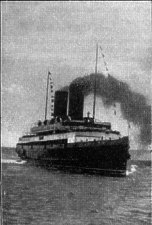
The "Ben "-A Snap Shot.
No later than the evening of Nov. 19, 1830, the two ;ships were anchored in Douglas Bay (there were no Victoria or Battery piers then), and again Captain Gill's unrivalled seafaring astuteness asserted itself. Like the famous Captain Nares, of Stevensonian fiction, he saw " something rather dirty coming " on " an iron-bound coast with an old Bob Ridley of a surf on it." Captain Gill kept steam up; Captain Tudor, of the "St. George," didn't. All night the wind had been O.S.W., but at 5 a.m. it shifted to a heavy squall from the S.E., whereupon Captain Gill at once put to sea; he returned for his passengers three hours later,. only to find the "St. George" a hopeless wreck on the rock now so well known to visitors as the Tower of Refuge.
This was the turning point in the fortunes of the Steam Packet Company, whose unique history it is not, however, my purpose now to write, though I hope it may be soon.
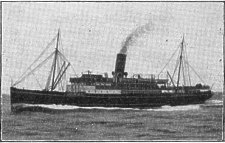
R.M.S. " Snaefell"--The "
Baby Liner."
I simply shew the extraordinary comparison of 1830 to 1910, calling particular attention to the excellent photo of the " Mona's Isle," which was given me by the late High Bailiff of Douglas some years ago. She was 105 feet long-about half the length of the present cargo boat, " Fenella "-and her engines were of 100 horsepower, with paddle wheels " for'ard " and not amidships. The stern was square, and really, from the display of glass therein, looked rather like a bay window. Square shutters guarded the port holes, and much was made of the sails, while the length of the funnel speaks for itself. She was the very first steamer to sport the "red with black top," the Cunard boats not starting till several years later. People often erroneously think that Manxmen followed Cunarders, but it is the other way about.
To compare her with the "Ben-My-Chree " is a task indeed! Here we have a steamer of a length which, not so long ago, would have been regarded as extreme for an Atlantic liner now engage in a two or three hours' holiday trip and managed with the ease and expertness of a ferry boat.
To give the builders' measurement, etc., is mere idle reiteration. To the tourist mind they convey nothing. Suffice it then the "Ben-MyChree" is far and away the largest, fastest, and most powerful coasting steamship ever built. She is, of course, elaborately fitted from stem to stern, and every department which can conduce to a traveller's comfort has been studied.
There are many thousands who read of the large ocean-going ships with pangs of regret, inasmuch as they are unable by lack either of time or funds to sail in them. Their regrets may now cease, for a few hours and a few shillings will ensure a trip on the "Ben-My-Chree," a vessel which could stow the original " Mona's Isle" on her deck.
T. E. E.
|
|
||
|
|
||
|
Any comments, errors or omissions gratefully received
The Editor |
||